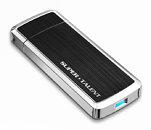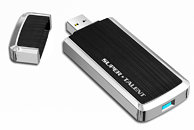Wednesday, November 4th 2009
Super Talent Announces World's First USB 3.0 RAIDDrive
Super Talent Technology, a leading manufacturer of Flash storage solutions and DRAM memory modules, today announced the new SuperSpeed USB 3.0 RAIDDrive, which supports transfer speeds up to ten times faster than USB 2.0 drives. The new drive, in 32GB, 64GB and 128GB capacities, is fully backward compatible with USB 2.0 ports, but operates at slower speeds.
The USB 3.0 RAIDDrive uses patented "multiple pairs of differential serial data lines technology" for optimal NAND flash performance. "This product underscores Super Talent's continued leadership in USB drives." said Super Talent COO, C.H. Lee. "We've developed the world's first mobile USB 3.0 flash drive. It delivers phenomenal performance and it incorporates our own patented technology".Measuring 95 x 37 x13.5 mm, the SuperSpeed drive is a truly portable drive. Like most USB drives, it requires no separate cable. It plugs directly into any USB port. Although this drive will work in USB 2.0, it delivers transfer speeds up to 200 MB/sec only in USB 3.0 ports. Using a separate UAS Protocol driver with a USB 3.0 port this SuperSpeed drive can reach up to 320 MB/sec transfer speeds. This product will be available in December from Super Talent resellers worldwide. Interested parties can register here for USB 3.0 product availability updates.
The USB 3.0 RAIDDrive uses patented "multiple pairs of differential serial data lines technology" for optimal NAND flash performance. "This product underscores Super Talent's continued leadership in USB drives." said Super Talent COO, C.H. Lee. "We've developed the world's first mobile USB 3.0 flash drive. It delivers phenomenal performance and it incorporates our own patented technology".Measuring 95 x 37 x13.5 mm, the SuperSpeed drive is a truly portable drive. Like most USB drives, it requires no separate cable. It plugs directly into any USB port. Although this drive will work in USB 2.0, it delivers transfer speeds up to 200 MB/sec only in USB 3.0 ports. Using a separate UAS Protocol driver with a USB 3.0 port this SuperSpeed drive can reach up to 320 MB/sec transfer speeds. This product will be available in December from Super Talent resellers worldwide. Interested parties can register here for USB 3.0 product availability updates.



26 Comments on Super Talent Announces World's First USB 3.0 RAIDDrive
And I do not understand your take on 'latency'. Are you referring to USB 2.0 flash drives' access times being higher than conventional HDDs thereby making them unsuitable for running an OS? If so, that is incorrect. Interface latency and access times for current USB 2.0 flash drives are lower than those of conventional HDDs. That is exactly what Windows Vista / 7 ReadyBoost feature exploits.
The thing that so far stood between USB 2.0 flash drives from running an OS were that conventional HDDs had a clear bandwidth advantage, and rarely did a USB 2.0 flash drive offer speeds of over 32 MB/s.